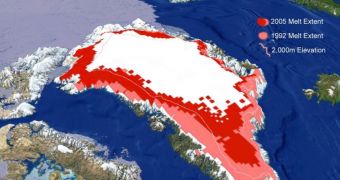If the ocean levels rose by 13 cm (5 in) only between 1940 and 1980, before the current speeding of the global warming, a phenomenon that prolonged the day on Earth by 0.001 second, you can imagine what happened in the last three decades and what will follow!... Tuvalu is already a flooded nation.
Paradoxically (or not), other islands have a different faith: Greenland is actually going upwards, rising up with 4 cm (1.6 in) annually, all this linked to the Greenland's melting ice cap.
"The Earth is elastic and if you put a load on top of it, then the surface will move down; if you remove the load, then the surface will start rising again. In the case of Greenland, the "load" is its ice cap" said Shfaqat Khan of the Danish National Space Center in Copenhagen.
Such uplift had been already detected on ancient "raised beaches", caused by the melting of ice after the last Ice Age, which raised land masses, leaving beaches meters above the water level.
Khan's team found the Greenland's uplift through GPS measurements taken on the bedrock, below the ice, during a surveillance started in 2001. The Greenland's southeastern tip is definitely going upwards and the rhythm of the rise has significantly increased in the last years.
"Before 2004, the uplift was about 0.5 cm to 1 cm per year. Since then, however, the land has been rising four times faster," Khan told New Scientist.
"This means that since 2004, Greenland has been losing four times more ice than before," he said.
These data match studies that assessed directly the loss of ice sheet.
"We are unsure what caused the acceleration. It is impossible to say if this speedy loss will be maintained in the long-term. It could be that more melt water is flowing into crevasses, which is making the glaciers flow into the ocean faster," said Khan. Molten water drills holes through the ice sheet and when this water reaches the bottom of the glaciers, it lubricates the bedrock, fastening the glaciers towards the sea, where they break off on icebergs that subsequently melt. And the annual snowfall clearly cannot replace the accelerated ice loss.

 14 DAY TRIAL //
14 DAY TRIAL //